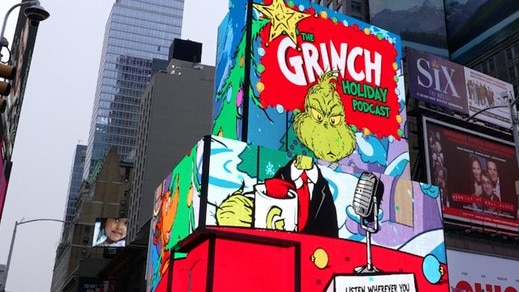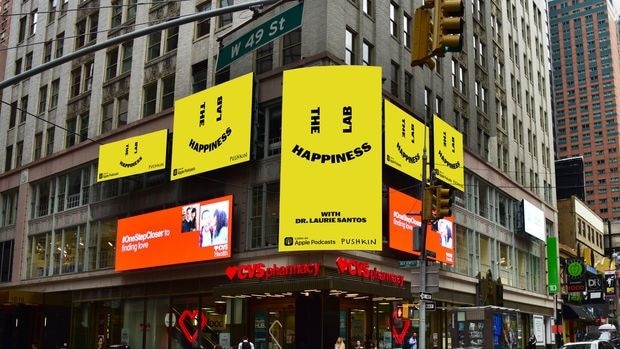Podcast companies begin to advertise like Hollywood studios
Stiffening competition pushes more audio companies to pay to advertise their shows like movies, after years of relying on word-of-mouth and cost-free cross-promotion.

In a shopping mall in Los Angeles’ Century City, a 1100sq m room has been painted green, covered in Christmas decorations and filled with an espresso bar, a fairy floss stand and a step-and-repeat for photo shoots. An actor dressed in a furry green suit makes an appearance on weekends.
The Grinch’s Holiday Green Room, as it is called, is one of LA’s latest “pop-up experiences,” the kind usually deployed to build excitement around big-budget TV shows and movies.
But this one is promoting a podcast, an entertainment format that until recently got by almost entirely with low-key marketing support – or virtually none at all.
For its new series “’Tis The Grinch Holiday Podcast,” Amazon podcast studio Wondery has rolled out in an expansive campaign that has more in common with the movie marketing playbook than the far cheaper one employed by many podcast makers for the past decade and a half: bartering host-read ads and hoping for a good placement on the homepage of podcast apps.
Other podcast companies are taking a similar approach as competition for listeners mounts and investors start to get serious about profitability. They are turning the audible into the visual to advertise shows across billboards, streaming platforms and the internet, and hiring marketing executives from studios and streamers to lead the charge, even while budgets across media and technology are squeezed.
“Our starting point was always Hollywood-style content,” said Nicole Blake, Wondery’s head of franchise development. “And now we’re bringing that Hollywood approach to how we go to market.” When barter isn’t enough Podcast listenership has been on an essentially upward trajectory since the medium first emerged alongside the iPod in the mid-2000s. The industry is primarily funded by two groups: advertisers sold on the premise that they can reach young, educated consumers, and technology companies looking to turn listeners into paying subscribers with a relatively cheap-to-produce form of media. Spotify, which this week said it would lay off 17 per cent of its workforce, has poured more than $1bn into the category.
Successful podcast companies in the 2010s seldom considered advertising their shows in the traditional sense, podcast executives said. With demand on the rise but the pool of shows still relatively small, most studios could rely on word-of-mouth, PR and old-fashioned bartering, whereby one podcast would advertise another in exchange for the same favour.
“We used to be able to roll out a podcast, mention it on a few other shows and boom, we’d have like 200,000 downloads a week, easy,” said Kristin Hume, senior director of brand and marketing at NPR.
Then a wave of new shows came, and never stopped coming. More than one million new podcast series were released in 2020, up from just over 23,000 in 2010, according to podcast search engine Listen Notes.
“Now there’s just so many other options out there that we have been really having to formalise how we roll them out,” Hume said.
The visuals that appear with a podcast in apps and in marketing also now require more investment, executives say. So more cash is being spent on designing striking artwork to stand out on the likes of Spotify and Apple Podcasts, and on filming studio talent for YouTube and TikTok. Offline, billboards are an appealing visual medium for podcast marketers, who still rarely have big enough budgets to buy TV commercials.
Podcasters including Slate, Pushkin Industries and iHeartMedia have placed ads in busy areas like Times Square and alongside roads across the country to spark interest among the general public for shows including “Slow Burn,” “The Happiness Lab” and “Atlanta Monster.” “Ultimately we’re not just trying to reach the folks who already know that they like to listen to podcasts – we’re trying to reach the people who don’t listen to podcasts yet because they haven’t found the right show,” said Eric Sandler, vice president overseeing marketing at Pushkin, the audio publisher co-founded by journalist Malcolm Gladwell.

Marketers like Sandler and NPR’s Hume have to convince their bosses that increasing media budgets is a good idea, even as budgets and staff numbers are elsewhere squeezed across media and technology companies. Data they have only been able to access relatively recently has helped them make that case, they say.
Analytics platforms such as Chartable have in the past few years emerged to help podcast marketers better attribute listeners to their marketing, a goal that has been challenging given the way podcasts are generally released on multiple hosting platforms, Hume said.
NPR, which went through a round of layoffs and had its marketing budget cut earlier this year, now advertises its podcasts on YouTube, Spotify and connected TV platforms including Hulu. Since 2021 it has run at least one million-dollar campaign a year, the latest of which promoted the work of its Black podcast hosts across the network.
“We produce these things to be heard and marketing is critical to that,” she said. “That’s really becoming more and more understood.” Other podcast companies have found they can increase their advertising footprint with minimal cost by placing ads across media properties owned by their parent companies.
iHeartMedia’s podcast network, the home of titles including the long-running “Stuff You Should Know ” and “Six Degrees with Kevin Bacon, ” places more than $100 million worth of ads a year across its broadcast radio stations for free, according to Conal Byrne, chief executive of the company’s Digital Audio Group.
The marketing plan for “’Tis The Grinch” includes placing ads on Amazon sites from IMDb to Audible, as well as a tie-in with the Amazon’s Ring doorbell. (Users can select an automatic reply voiced by the character.) Podcast brands, not just podcasts The great podcast saturation has pushed companies to think more deeply about their brand to build a loyal audience across multiple shows. More companies are following the path of streaming services and magazine publishers by launching subscription models, offering live events and access to talent as part of a package deal.
“We’re absolutely taking a page out of the Hollywood book, largely because that’s sort of how I’ve always promoted streaming video subscription platforms,” said Nada Arnot, who in March joined the Economist Group as executive vice president for marketing from British streaming service BritBox. The publisher, which puts out a range of daily, weekly and limited series podcasts, in October introduced Economist Podcasts+, a $49-per-year subscription the company expanded its marketing budget to promote, Arnot said.
Crooked Media, the home of podcasts including “Pod Save America ” and the Rosamund Pike-starring comedy “Edith!, ” aims to cut through as a politically-minded, activist-focused media company in part through algorithmic engineering, according to the company’s head of marketing and communications, Crystal Ponzio-Busto.
That means making sure the videos and advertising the company uploads to promote its podcasts are tagged with relevant keywords and targeted at people more likely to engage with its content, said Ponzio-Busto, who was previously global marketing director at Netflix.
Blake, the Wondery executive behind the Grinch campaign, joined the company in 2021 from Warner Bros., where she led global franchise development of the Harry Potter brand.
The company, which declined to say how much it is spending on the Grinch campaign, now plans to apply the tried-and-tested Hollywood concept of intellectual property to more podcasts, prioritising ideas that might expand into books, TV series, live events and other podcasts, Blake said. It needs multipronged marketing campaigns to generate enough interest from audiences and partners to make that happen, she said.
“We are using every bit of fire power at Wondery that we have to do this, ” Blake said of the Grinch campaign. “You will see it, you will hear about it.”
The Wall Street Journal


